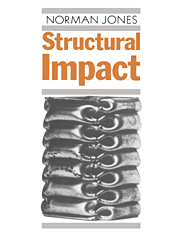Book contents
- Frontmatter
- Contents
- Preface
- 1 Static plastic behaviour of beams
- 2 Static plastic behaviour of plates and shells
- 3 Dynamic plastic behaviour of beams
- 4 Dynamic plastic behaviour of plates
- 5 Dynamic plastic behaviour of shells
- 6 Influence of transverse shear and rotatory inertia
- 7 Influence of finite displacements
- 8 Strain rate sensitive behaviour of materials
- 9 Dynamic progressive buckling
- 10 Dynamic plastic buckling
- 11 Scaling laws
- Appendices
- References
- Answers to selected problems
- Subject index
- Author index
2 - Static plastic behaviour of plates and shells
Published online by Cambridge University Press: 09 January 2010
- Frontmatter
- Contents
- Preface
- 1 Static plastic behaviour of beams
- 2 Static plastic behaviour of plates and shells
- 3 Dynamic plastic behaviour of beams
- 4 Dynamic plastic behaviour of plates
- 5 Dynamic plastic behaviour of shells
- 6 Influence of transverse shear and rotatory inertia
- 7 Influence of finite displacements
- 8 Strain rate sensitive behaviour of materials
- 9 Dynamic progressive buckling
- 10 Dynamic plastic buckling
- 11 Scaling laws
- Appendices
- References
- Answers to selected problems
- Subject index
- Author index
Summary
Introduction
An introduction to the static plastic behaviour of beams was presented in the preceding chapter, together with some theoretical solutions for several problems. It was observed that the idealisation of a perfectly plastic material, which is shown in Figures 1.3 and 1.4, is particularly attractive and simplifies considerably any theoretical calculations for the static plastic collapse load of a beam. Moreover, Figure 1.14 shows that the theoretical predictions for the static plastic collapse load give reasonable agreement with the corresponding experimental results on freely supported steel beams subjected to a central concentrated load. Good agreement between experimental results and the corresponding theoretical predictions for the static plastic collapse loads of many beams and frames may be found in the articles cited in the previous chapter.
The general concepts introduced in the previous chapter for beams are now used to study the static plastic collapse behaviour of plates and shells, which are important practical structures found throughout engineering. However, the theoretical analyses are more complex than for beams because the plastic flow in plates and shells is controlled by multi-dimensional yield criteria.
The generalised stresses and strains for plates and shells are introduced in the next section, while some basic concepts, which are associated mainly with multidimensional yield criteria, are discussed in § 2.3. The plastic collapse theorems are stated in § 2.4, together with some useful practical corollaries. Sections 2.5 to 2.11 contain the basic equations and some theoretical solutions for the static plastic collapse loads of circular plates, rectangular plates and axisymmetric cylindrical shells.
- Type
- Chapter
- Information
- Structural Impact , pp. 22 - 61Publisher: Cambridge University PressPrint publication year: 1990



